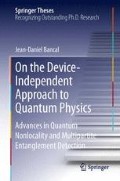Abstract
The violation of a Bell inequality with space-like separated measurements precludes the explaination of nonlocal correlations in terms of causal influences propagating slower than light. Yet, these correlations can still be explained in a causal manner if one gives up Bell’s locality condition. Indeed, this is the explanation followed when one says something like “A measurement on the singlet state \(|\psi ^-\rangle =\frac{1}{\sqrt{2}}(|01\rangle -|10\rangle )\) yielding result ‘0’ in the computational basis of Alice prepares the state \(|1\rangle \) for Bob”. With a slightly different taste, Bohmian mechanics also provides a causal explanation for quantum correlations, which does not rely on quantum steering or collapse of the wavefunction. However, both of these explanations are much more nonlocal than a simple violation of Bell’s local causality condition implies: not only do they involve faster-than-light influences at a distance, but these influences also have immediate effects on distant particles no matter how far away they are from each other. Here we question whether such a strong violation of the notion of locality is necessary or not.
Access this chapter
Tax calculation will be finalised at checkout
Purchases are for personal use only
Notes
- 1.
As a matter of fact, the same remark applies to instantaneous influences of the kind we just mentioned above.
- 2.
Note that signalling could be activated in cases where the model only produces no-signalling correlations as well. Indeed, if a marginal probability distribution can have different (no-signalling) values depending on the time chosen by some other party to perform his measurement, in the fashion of [4, 5], this change in the correlation can allow to guess the time of measurement chosen by a distant party. However we don’t consider this possibility here.
References
T. Mauldin, Quantum Non-Locality and Relativity: metaphysical Intimations of Modern Physics (Blackwell Publishers, Oxford, 2002)
D. Salart, A. Baas, C. Branciard, N. Gisin, H. Zbinden, Nature 454, 861 (2008)
B. Cocciaro, S. Faetti, L. Fronzoni, Phys. Lett. A 375, 379 (2011)
V. Scarani, N. Gisin, Phys. Lett. A 295, 167 (2002)
V. Scarani, N. Gisin, Braz. J. Phys. 35, 2A (2005)
S. Coretti, E. Hänggi, S. Wolf, Phys. Rev. Lett. 107, 100402 (2011)
Author information
Authors and Affiliations
Corresponding author
Rights and permissions
Copyright information
© 2014 Springer International Publishing Switzerland
About this chapter
Cite this chapter
Bancal, JD. (2014). Finite-Speed Hidden Influences. In: On the Device-Independent Approach to Quantum Physics. Springer Theses. Springer, Cham. https://doi.org/10.1007/978-3-319-01183-7_9
Download citation
DOI: https://doi.org/10.1007/978-3-319-01183-7_9
Published:
Publisher Name: Springer, Cham
Print ISBN: 978-3-319-01182-0
Online ISBN: 978-3-319-01183-7
eBook Packages: Physics and AstronomyPhysics and Astronomy (R0)

